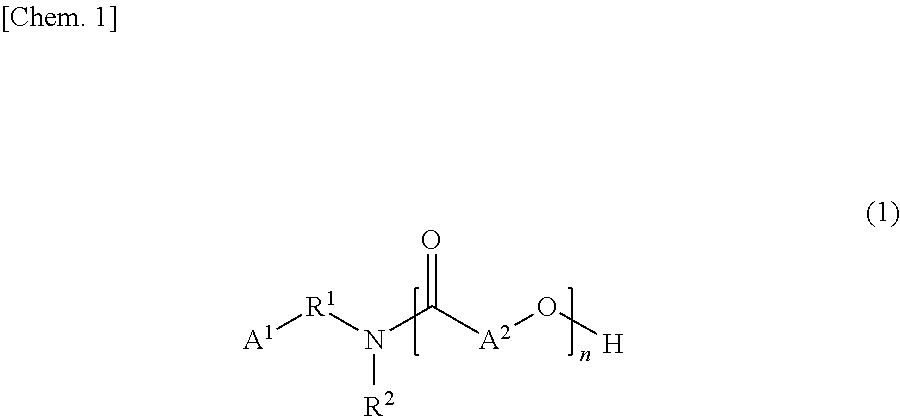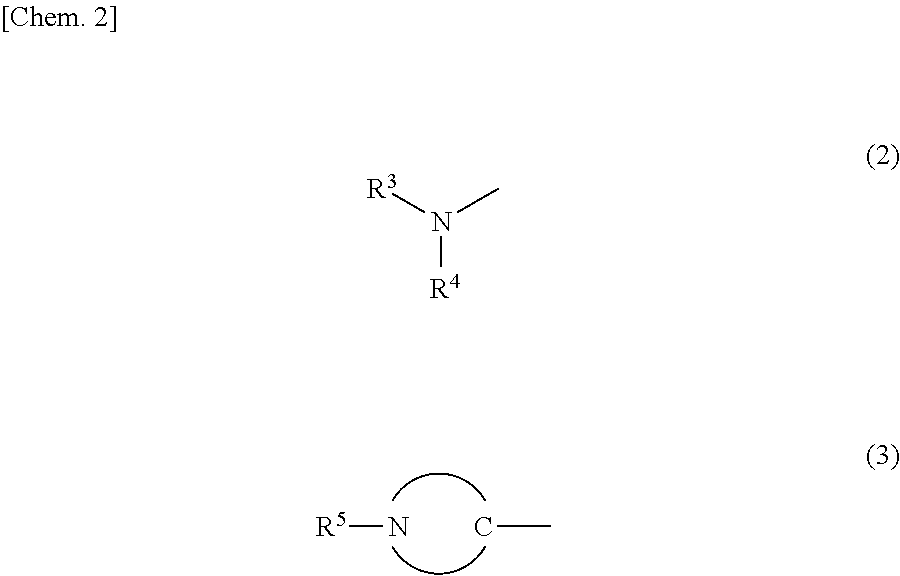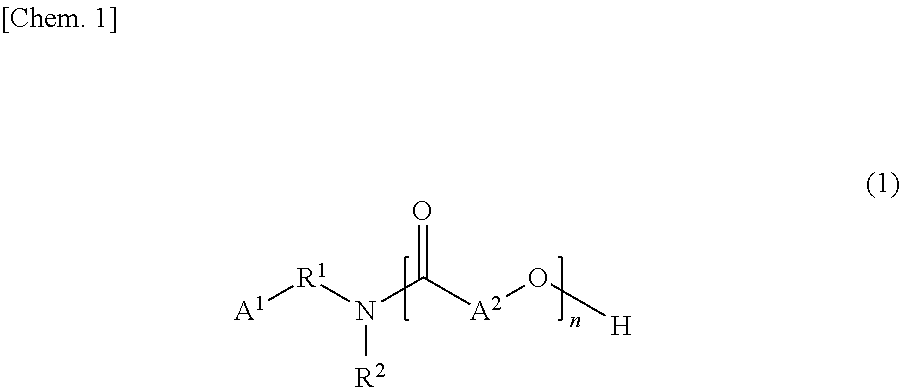Tertiary-nitrogen-atom-containing lactone polymer having polymerizable group, and method for producing same
a technology of lactone and nitrogen atoms, which is applied in the field of lactone polymers containing tertiary nitrogen atoms and polymerizable groups, can solve the problems of disadvantageously failing to contribute to desired performance and poor handling, and achieves high affinity for water interface, high dispersibility, and satisfactory adhesion to pigments.
- Summary
- Abstract
- Description
- Claims
- Application Information
AI Technical Summary
Benefits of technology
Problems solved by technology
Method used
Image
Examples
example 1
Synthesis of Polymer (Tertiary-Nitrogen-Containing Lactone Polymer) by Lactone Ring-Opening Addition Polymerization of 3-(N,N-Dimethylamino)Propylamine
[0108]Materials, i.e., 123.68 g (1.21 mol) of 3-(N,N-dimethylamino)propylamine and 276.32 g (2.42 mol) [2 moles per mole of 3-(N,N-dimethylamino)propylamine] of ε-caprolactone were placed in a four-neck separable flask equipped with a stirrer, a thermometer, a nitrogen gas inlet tube, and a condenser and were allowed to react with each other at 120° C. until the reaction liquid had an amine value of 170 KOH-mg / g. The reaction liquid was then raised in temperature to 160° C., allowed to react until the residual ε-caprolactone content reached less than 1 percent by weight based on the total amount of the reaction liquid, where the content was determined by GC analysis, and yielded a lactone polymer (tertiary-nitrogen-containing lactone polymer) that was liquid at room temperature (25° C.). The reaction liquid had a content of residual 3...
example 2
Synthesis 1 of Polymerizably Reactive Polylactone Compound
[0110]Materials were prepared as 26.89 g of isocyanurate trimer of HDI (trade name “TAKENATE D-170N”, supplied by MITSUI TAKEDA CHEMICALS, INC., having an NCO concentration in percentage of 20.1%) and 14.18 g of the tertiary-nitrogen-containing lactone polymer synthesized in Example 1, 0.050 g of methoquinone, and 0.020 g of dibutyltin dilaurate (DBTDL) (trade name NEOSTANN U-100, supplied by Nitto Kasei Co., Ltd.). The materials were placed in a four-neck separable flask equipped with a stirrer, a thermometer, an air-gas mixture inlet tube, and a condenser. After the reaction system internal temperature was adjusted to 70° C., 58.93 g of an ε-caprolactone-modified acrylate monomer (trade name “PLACCEL FA5”, supplied by Daicel Corporation) were added at the time point when the residual isocyanate group concentration reached 1.7 percent by weight based on the total amount of the reaction liquid. The reaction was further perfor...
example 3
Synthesis 2 of Polymerizably Reactive Polylactone Compound
[0111]A glass reactor equipped with a stirrer, a condenser, a thermometer, and a dropping funnel was purged with nitrogen and charged with 42.4 g (0.12 mol) of the tertiary-nitrogen-containing lactone polymer synthesized in Example 1, 90 g of acetonitrile, and 19.4 g (0.19 mol) of triethylamine. The mixture in the reactor was cooled down to 2° C. with stirring on an ice bath and further combined with 18.8 g (0.18 mol) of methacryloyl chloride added dropwise from the dropping funnel over 30 minutes. After the completion of the dropwise addition, the mixture was stirred while maintaining the liquid temperature at 5° C. until the disappearance of hydroxy group was verified in NMR analysis. The reaction liquid was combined with 90 g of toluene and then combined with 90 g of water over 30 minutes while being cooled on ice to maintain the liquid temperature at 15° C. or lower. An organic layer was separated, combined with 0.4 g of ...
PUM
| Property | Measurement | Unit |
|---|---|---|
| viscosity | aaaaa | aaaaa |
| viscosity | aaaaa | aaaaa |
| viscosity | aaaaa | aaaaa |
Abstract
Description
Claims
Application Information
 Login to View More
Login to View More - R&D
- Intellectual Property
- Life Sciences
- Materials
- Tech Scout
- Unparalleled Data Quality
- Higher Quality Content
- 60% Fewer Hallucinations
Browse by: Latest US Patents, China's latest patents, Technical Efficacy Thesaurus, Application Domain, Technology Topic, Popular Technical Reports.
© 2025 PatSnap. All rights reserved.Legal|Privacy policy|Modern Slavery Act Transparency Statement|Sitemap|About US| Contact US: help@patsnap.com



